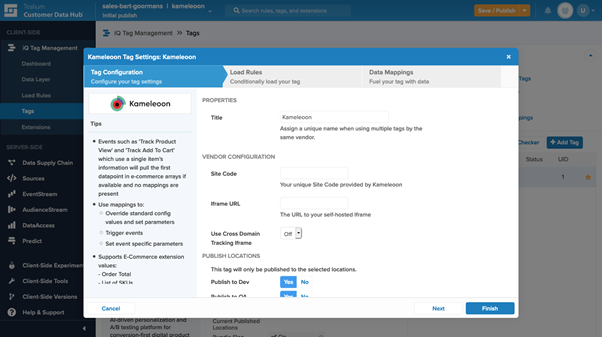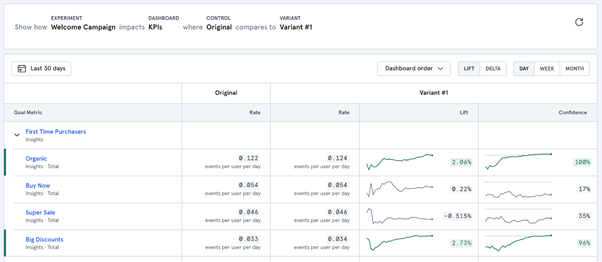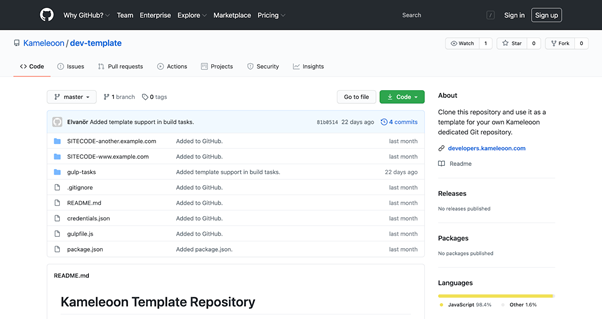
Must-have integrations for your a/b testing tool in 2021
No great tool is an island. That means a powerful A/B testing platform must be able to connect to the tools you use the most, and fasttrack the impact of your testing program.
“There is no shortage of third party integrations to help maximize the impact of an experimentation program. However, what's really important is the customizability of those bridges to really adapt to your own, usually unique setup,” says Jean-Noël Rivasseau, CTO, Kameleoon.
But we’ve all seen the charts that show how many martech and CX tools there are out there - where do you start and which integrations really add value?
To help surface the must-have integrations for your test and learn program, we asked experts from around the experimentation community for their views and recommendations. We also cross-checked what integration types were included for all leading A/B testing platforms to prepare this list. It isn’t meant to be exhaustive.
“The list of tools I’d like to integrate with comes down to what I (and the client) are using at the moment. So if the client is using Google Analytics, I want to send my data there. If they move to Adobe Analytics I’ll send my data there,” says Silver Ringvee, CTO for Speero, a customer experience optimization agency formerly known as CXL Agency.
At the end of the day, what works best for your program is the real must-have. And for more on how to successfully build an effective martech stack, check out this in-depth post from CXL.
We’ve organized integrations into three buckets:
To help we’ve grouped tools into three large (and sometimes overlapping) buckets:
- Data coming in. You need access to a complete profile of customers and their journeys on all devices and channels to be able to create the most impactful experiences
- Analytics data going out. You have to know how the changes you made affected customer behavior, being able to analyze accurate results easily
- Making the process simple. You’re busy - you need integrations that make your work, and thus your life, easier.
While we’ve bucketed together tools that provide data to your experimentation platform, such as CRM, CDPs and UX optimization solutions, and separated them from analytics tools, often the lines are a bit more blurred. “Many of these tools can integrate so you can operate bidirectionally, taking data back in from your experiments to help with analytics and reporting too,” adds Jean-Noël.
For more on building an experimentation marketing stack read this piece from Widerfunnel.
1 Gather and segment your customer data
We all operate in a data-driven world - testing and experimentation is about using this data to drive better decisions that improve the experience for our customers.
Data comes in from (and goes out to) a wide variety of sources. Your experimentation platform needs to be able to access all your existing data sources and tools to let you:
- discover where you should experiment
- segment your audiences;
- and maximize your martech investment.
These are the must-have integration types for incoming data:
Customer Relationship Management (CRM) integrations
You already have huge troves of data about your customers and subscribers stored in your Customer Relationship Management (CRM) system. Integrate with your platform and use this to segment your audience when running experiments (such as only targeting certain customer groups) to see what appeals to different demographics. Don’t forget the need for consent management and compliance (which we’ll cover later on) when using identifiable customer data though. And, of course look at how your experiments drive results later in the funnel.
“Getting downstream lead stage data back into experiment results is crazy helpful. And tying Net Promoter Score or Voice of the Customer data to a test result is great as well. You need to be able to track the impact of experiments all the way through the business,” says Ben Labay, Speero’s Managing Director.
Common CRM/marketing automation tools include:
Customer Data Platform (CDP)/Data Management Platform (DMP) integrations
Alongside CRM solutions, you need your experimentation platform to access all the sources of data on your visitors that you have within your marketing ecosystem. So that means linking seamlessly to your Customer Data Platform (CDP) and Data Management Platform (DMP).
Key CDPs and DMPs to potentially connect to include:
- Commanders Act (CDP)
- Datavirtuality (DMP)
- mParticle (CDP)
- Oracle DMP (formerly Bluekai)
- Salesforce Audience Studio (formerly Krux DMP)
- Segment (CDP/Data warehouse)
- Tealium (CDP)

Integrating experimentation with data inside the Tealium CDP
User Experience (UX) optimization integrations
Prioritizing what, where and when to test on your site starts by analyzing customer behavior. Where are visitors frustrated and where can you improve the user experience you deliver? Starting with the data in UX and session replay tools you can pinpoint the areas to focus on in your testing. And when you are running your tests you need to measure how they change the needle for user behavior, so you need to be able to link UX to experimentation tools, sharing data bidirectionally.
The most common UX tools integrated with experimentation platforms include:
2 Discover how behavior changed (Analytics):
The main point of running an experiment is to see whether it changes consumer behavior in either the online or offline world. And you then need to be able to drill into these results to find out whether this change was positive or negative, which segments it impacted most, and how it moves business metrics. Reporting is vital to show the value of testing, to drive data-driven decision making and to create a culture of experimentation.
Analytics tools
Analytics tools are a staple of digital marketing, giving you detailed results of the performance of your website and how visitors interact with it. While everyone knows big-hitters such as Google Analytics and Adobe Analytics, and often use them as part of a wider corporate standardization, other tools such as AT Internet, Heap, Quantum Metric and Mixpanel can deliver valuable additional insights based on experimentation data.
"My view is that every single company should have one of Google Analytics or Adobe Analytics, which I call a "primary analytics platform". Then next I would add a "supplementary analytics platform" - this doesn’t replace GA or AA but is a good way to add additional analytics," says Michael St. Laurent, Director of Experimentation Strategy & Product Development at Widerfunnel.
Common analytics tools to look at include:
- Adobe Analytics
- Adobe Audience Manager
- AT Internet
- Etracker
- FullStory
- Google Analytics
- Heap
- Kissmetrics
- Mixpanel

Monitoring the impact of experiments on business KPIs with Mixpanel
Downstream/offline analytics
We live in an increasingly complex omnichannel world, with consumers switching between online and offline during their customer journey. That means that experiments have to be deployed across every channel, so that a consumer sees the same variant and receives the same experience when they get an email, open your app, visit your site, view an ad on Facebook or make contact in other ways, such as by calling your contact center.
Equally, you need to be able to measure the impact of experiments across downstream and offline channels, and how they have impacted metrics such as Net Promoter Score (NPS). That means your platform needs an API to link to offline solutions, as well as integrations with call tracking tools.
There are a wide variety of downstream tracking tools, although in many cases integrations are custom-created via your platform’s API:
- CallTrackingMetrics (call tracking)
- Decibel (call tracking/analytics)
- Freespee (lead tracking and management)
- Infinity Tracking (call tracking)
- Invoca (call tracking)
- Mediahawk (call tracking)
3 Making your life and experimentation programs easier
There’s increasing pressure to accelerate the velocity of experimentation programs - and that means you need to make the process of planning, creating, deploying and analyzing tests seamless. You don’t want to have to learn new skills unnecessarily or have to change your workflows because a tool doesn’t support how your organization gets things done. Being able to operate in the environments you are familiar with improves productivity and delivers an end-to-end experimentation process.
Development and Collaboration Environments
Experimentation is increasingly becoming a practice managed by developers and product owners - and they want to be able integrate testing platforms into their existing development workflows.
Integrations with widely used code repositories such as Git and development environments such as Microsoft Visual Studio Code allow developers to create and store experiments using the skills and tools they are already familiar with, and automatically synchronize them to their testing platform. Additionally, connecting to collaboration tools such as Slack lets you keep teams up to date with the progress of experiments through notifications.
Potential tools to integrate with include:

Organizing experiment and personalization code files in a Git repository
Experimentation Management Solutions
Successfully scaling your experimentation program requires a central tool to manage team activities, from selecting test hypotheses to viewing aggregated results across the program. Automatic integration between your testing tool and experimentation management platforms boosts productivity and helps achieve success.
Integrations you can consider:
“Having a good testing tool isn't enough anymore. How are you storing your customer insights? How are you automating your process? How are you communicating value with stakeholders and executives? How are you intaking ideas into your backlog? An experimentation management solution solves these challenges,” explains Michael St. Laurent of Widerfunnel. “Adding an experiment management integration, like Liftmap, helps optimizers get the most value out of their testing platform.”
Content Management Systems (CMS) integrations
Popular websites sell tens of thousands of products, meaning they have huge numbers of product pages in their Content Management System (CMS). Being able to quickly access this content and test different variations of pages enables brands to continually improve what customers see, without having to manually recreate pages in your experimentation platform. “When you have a LOT of content/products, some sort of CMS integration is helpful. It just makes things easier when producing variations, shortening development time,” says Rommil Santiago, founder of Experiment Nation.
Tools to integrate with include:
Consent Management
Consumers and regulators are increasingly demanding transparency over how personal data is shared and used. Compliance with regulations such as the CCPA and GDPR requires consumers to have greater control over how their data is used - so brands need to provide the ability for them to easily give or withhold consent.
While regulations (and their interpretation) vary globally, visitors may need to give explicit consent before they are bucketed in an experiment, particularly if it uses personal data or IP geolocation as segmentation criteria. Being able to integrate seamlessly with consent management platforms such as Didomi and Usercentrics, as well as meet standards such as the United States Health Insurance Portability and Accountability Act (HIPAA) and IAB Europe’s Transparency and Consent Framework (TCF) gives the flexibility and control that experimentation teams need.
Consent management integrations to look at include:
Moving beyond pre-built integrations
There’s a huge number of tools out there, that can be used in an almost infinite number of combinations and ways. That means that pre-built integrations may only take you so far - either they don’t quite meet your exact needs, don’t provide the right data, or don’t give the flexibility required to seamlessly integrate multiple tools.
“In my opinion being ready to be integrated is more important than ready-made plug-and-play integrations. I find it much better to be able to access the necessary data using JavaScript, Data Layer, or some other API. Then format the data based on my needs, and send it to whatever tool I want to use it in,” says Silver from Speero.
In this blog we’ve tried to pull together a list of the types of must-have integrations for successful testing programs. But we know that everyone has their own favorites. Is there an integration you can't live without? Tell us what we may have missed. Email [email protected]



